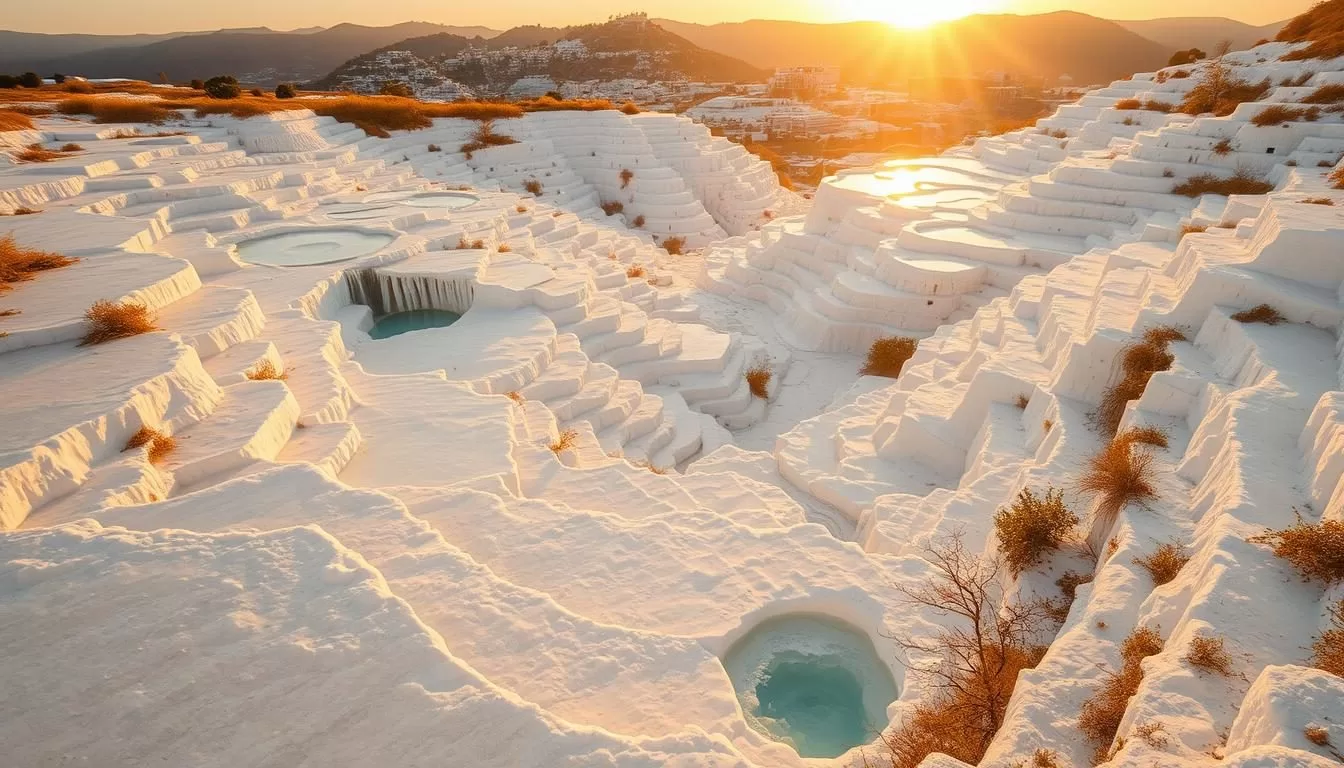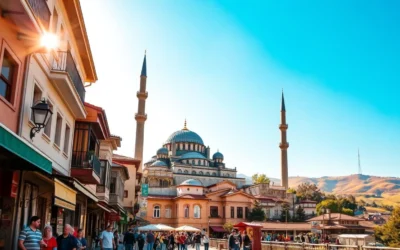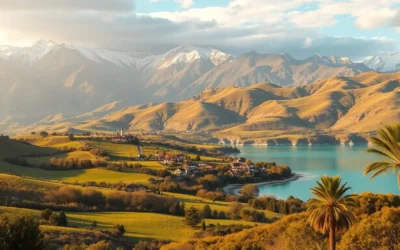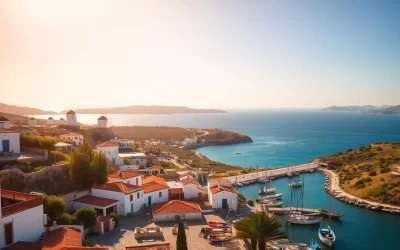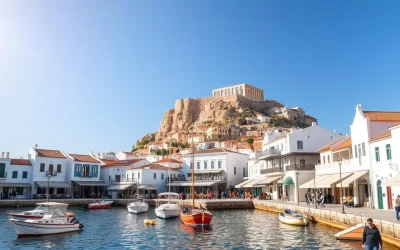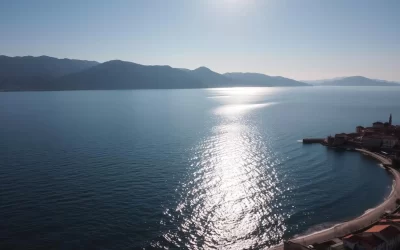Imagine a surreal landscape of white travertine terraces cascading down a hillside, filled with powder-blue water. This is Pamukkale, a natural wonder that has captivated visitors for over 2,000 years.
As you visit Pamukkale, you’ll discover a unique blend of natural beauty and historical significance. This UNESCO World Heritage Site is home to the ancient city of Hierapolis, with its well-preserved ruins offering a glimpse into the area’s rich history.
Whether you’re looking for relaxation or adventure, Pamukkale has something for everyone. From bathing in thermal pools to exploring ancient ruins, this guide will help you plan the perfect trip to this extraordinary destination.
Discovering the Natural Wonder of Pamukkale
Located in Turkey, Pamukkale is a geological marvel that has captivated visitors for centuries. The site is famous for its white travertines, a natural wonder that has been formed over thousands of years.
![]()
The Geological Marvel of the White Travertines
The white travertines of Pamukkale are a result of calcium-rich thermal waters cascading down the hillside, creating terraced pools. This natural phenomenon has deposited calcium carbonate, which solidified into the dazzling white terraces that give Pamukkale its distinctive appearance. The terraces contain mineral-rich water that has been valued for its therapeutic properties since the 2nd century BC.
| Feature | Description |
|---|---|
| Formation | Calcium-rich thermal waters |
| Appearance | Dazzling white terraces |
| Historical Significance | Therapeutic properties since 2nd century BC |
The Legend Behind the “Cotton Castle”
According to local legend, a young woman who couldn’t find love attempted to end her life by jumping from the travertines but instead fell into the pools and emerged as a beautiful woman. This legend explains the magical effect you get from bathing in the pool, enhancing your overall experience at the site. The name “Pamukkale” translates to “Cotton Castle” in Turkish, perfectly describing the fluffy, cloud-like appearance of the white calcium formations. Designated a UNESCO World Heritage Site in 1988, Pamukkale continues to attract visitors worldwide.
Bathing in the Famous White Travertine Pools

The white travertine pools in Pamukkale offer a unique bathing experience, surrounded by a landscape that has been shaped over thousands of years. As you walk through this natural wonder, you’ll be immersed in a surreal environment where the warm, mineral-rich waters have created a breathtakingly beautiful landscape.
When you visit Pamukkale, bathing in the famous white travertine pools is an absolute must-do experience that connects you to thousands of years of history. The travertines are not just a visual marvel but also a place where you can unwind and rejuvenate.
Tips for the Best Bathing Experience
To make the most of your visit, consider a few tips. First, be prepared to remove your shoes before walking on the travertines, as this helps preserve the delicate calcium formations and allows you to feel the warm mineral water between your toes.
- For a more peaceful bathing experience, head to the lower levels of the travertines where fewer tourists venture, giving you space to relax and soak in the therapeutic waters.
- The best time to enjoy the pools is either early morning (around opening time at 6:30 AM) or late afternoon when the crowds thin out and the lighting creates a magical atmosphere.
By following these tips, you can enhance your bathing experience and enjoy the travertine pools to the fullest.
Photography Opportunities at the Travertines
The white travertines of Pamukkale offer incredible photography opportunities, especially when the sun is setting. The contrast between the white calcium formations and the turquoise water creates stunning visuals.
- Bring a waterproof camera or phone case to capture stunning photos while bathing, as the unique landscape offers endless opportunities for great shots.
- Visit during sunset for the most spectacular photography conditions, when the setting sun makes the white travertines glow with golden and pink hues.
- Plan your day so you have enough time to both bathe and take photos, as you’ll want to experience the pools from different angles and in different lighting conditions.
Whether you’re a professional photographer or just looking to capture memories, the travertines offer a unique and breathtaking backdrop for your photos.
Exploring the Ancient City of Hierapolis

Hierapolis, an ancient Greek city founded around 190 BC, is a treasure trove of historical significance waiting to be explored. As you wander through the ancient city, you’ll discover the rich history and culture of a Greco-Roman spa city that was once a popular destination for wealthy retirees.
The Historical Significance of Hierapolis
The city of Hierapolis has a rich history dating back to the 2nd century BC, when it was built as a Greco-Roman spa city. The presence of a sizable necropolis within the city sheds light on the citizens who used to live here in the past. Primarily, they were retirees who were seeking to escape the hustle and bustle of other Greek cities and savor their final days at the spa.
The historical significance of Hierapolis is further emphasized by its well-preserved ruins, which include a grand colonnaded street, various temples, and a monumental arch. The site offers a unique opportunity to experience both natural wonders and historical treasures in one area.
Must-See Ruins in the Ancient City
As you explore the ancient city, you’ll walk the same paths as ancient travelers who came to the city to benefit from the healing thermal waters over 2,000 years ago. The extensive necropolis, with over 1,200 tombs, is one of the largest ancient cemeteries in Anatolia, showcasing the city’s importance and wealth.
Be sure to visit the remains of various temples, a Byzantine church, and other structures that tell the story of this once-thriving city in the 2nd century BC. The well-preserved ruins will transport you back in time, allowing you to experience the history and culture of Hierapolis firsthand.
Visiting the Great Theater of Hierapolis
As you explore the ancient city of Hierapolis, one of the most breathtaking structures you’ll encounter is the Great Theater of Hierapolis. This massive amphitheater, constructed in the 2nd century AD by the Roman Empire, is a testament to the region’s rich history and architectural prowess. With a seating capacity of over 15,000, it’s an awe-inspiring sight that transports you back to an era of grand performances and spectacular entertainment.
The Architecture and History of the Theater
The Great Theater of Hierapolis is renowned for its impressive architecture and historical significance. Built during the Roman era, this amphitheater is one of the largest and best-preserved ancient theaters in Turkey. As you explore the theater, you’ll notice the intricate details that have survived for nearly two millennia, including the ornate stage building with its decorative elements. The theater’s design and construction reflect the advanced engineering skills of the Romans, making it a fascinating place to explore for history enthusiasts.
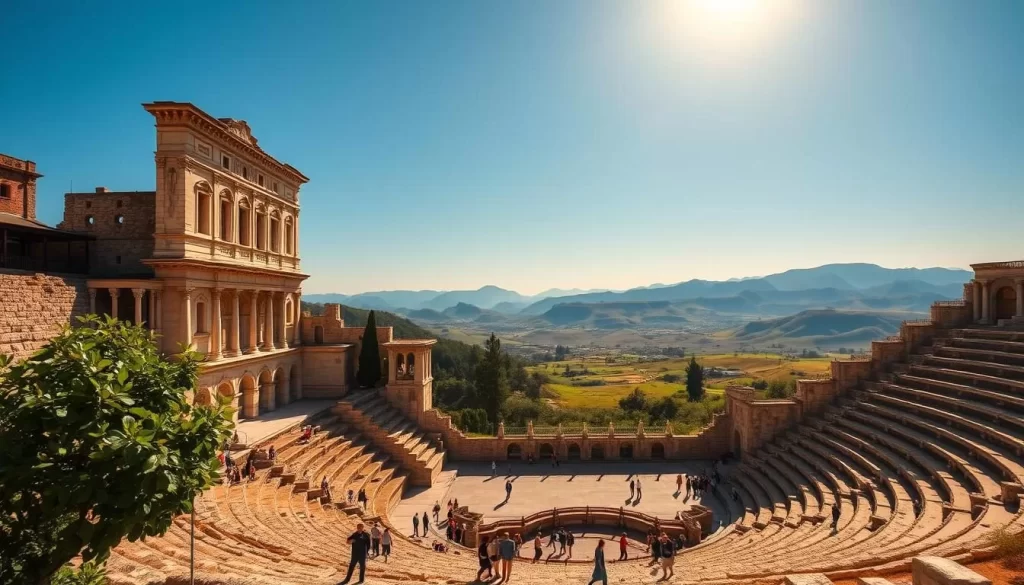
Best Viewpoints for Photographs
Climbing to the top rows of the theater rewards you with breathtaking panoramic views of the entire ancient city and the surrounding landscape, including the white travertines in the distance. This vantage point offers some of the best photo opportunities in all of Pamukkale, especially during the golden hour when the light bathes the ancient stones in a warm glow. To capture the essence of this ancient city, consider visiting during the early morning or late afternoon when the light is soft and golden.
Visiting the Great Theater is one of the essential things to do in Pamukkale, offering both historical significance and spectacular views. As you explore this ancient wonder, you’ll gain a deeper appreciation for the region’s history and the importance of preserving such cultural landmarks.
Relaxing in Cleopatra’s Antique Pool

The allure of Cleopatra’s Antique Pool lies in its unique blend of history, natural beauty, and therapeutic waters. This ancient pool offers you a chance to swim in the same thermal waters that have attracted visitors for centuries, including, legend has it, Queen Cleopatra herself.
The pool is filled with crystal-clear, mineral-rich water at a constant temperature of about 36°C (97°F), providing a warm and therapeutic swimming experience throughout the year. What makes this pool truly special is the presence of ancient marble columns and other architectural fragments that lie partially submerged in the water – remnants of the Roman structures that once stood here.
The Healing Properties of the Thermal Waters
The thermal waters at Cleopatra’s Antique Pool are rich in calcium, magnesium, bicarbonate, and sulfur, which are believed to help with various health conditions, including rheumatism, skin diseases, and circulation problems. The pools are constantly refreshed with calcium-laden water, enhancing their therapeutic properties.
Swimming Among Ancient Roman Columns
Unlike the travertines, Cleopatra’s Antique Pool has cleaner, clearer water that’s constantly refreshed, making it a more comfortable swimming experience. Be aware that there is a separate entrance fee for the Antique Pool (approximately 200 TRY or $10 USD) in addition to the main Pamukkale entrance fee.
Taking to the Skies: Aerial Adventures in Pamukkale
Experience the thrill of aerial adventures in Pamukkale, Turkey, and discover the breathtaking beauty of this natural wonder from a new perspective. For a truly unforgettable perspective of Pamukkale, you can take to the skies with aerial adventures that showcase the full splendor of this natural wonder.
Hot Air Balloon Rides at Sunrise
Hot air balloon rides offer a peaceful and magical way to experience Pamukkale, floating silently above the white travertines and ancient ruins as the first light of day illuminates the landscape. The best hot air balloon experiences take place at sunrise when the early morning light creates a stunning contrast between the white calcium terraces and the turquoise pools, with fewer crowds below.
During your hot air balloon flight, you’ll gain a unique bird’s-eye view of how the entire travertine formation cascades down the hillside and how it connects to the ancient city of Hierapolis.
Paragliding Over the White Terraces
For those seeking more adrenaline, paragliding over Pamukkale provides an exhilarating alternative that combines the thrill of flight with spectacular views. Paragliding tours typically last about 15-20 minutes and include an experienced pilot who will guide you safely through the air while pointing out key landmarks below.

Both hot air balloon rides and paragliding are weather-dependent activities, so it’s advisable to book these things to do in Pamukkale early in your trip to allow for possible rescheduling if needed. These aerial adventures give you a comprehensive understanding of Pamukkale’s scale and beauty that simply can’t be appreciated from ground level.
Pamukkale, Turkey: Best Things to Do Beyond the Main Attractions
For those looking to venture beyond the main attractions in Pamukkale, there are several intriguing day trip opportunities that showcase the region’s rich history and culture.
Day Trip to Aphrodisias Ancient City
Aphrodisias Ancient City, located about 2.5 hours’ drive from Pamukkale, offers some of the most impressive and well-preserved ruins in Turkey without the crowds of better-known sites. You’ll be amazed by Aphrodisias’ Temple of Aphrodite, built in the 3rd century BC, and the remarkable stadium that could seat 30,000 spectators – one of the best-preserved ancient stadiums in the world.
The city was renowned for its school of sculpture, and you can see many exquisite marble carvings and statues in the on-site museum that showcase the exceptional artistic talent that flourished here.
Exploring the Ruins of Laodicea
Just a short 15-minute drive from Pamukkale lies Laodicea, an ancient city mentioned in the Bible’s Book of Revelation as one of the Seven Churches of Asia. Exploring the ruins of Laodicea, you’ll discover well-preserved structures including a stadium, gymnasium, and one of the largest ancient theaters in Turkey, often with far fewer visitors than at Hierapolis.
These day trips allow you to escape the crowds at the main Pamukkale attractions while still experiencing significant archaeological sites that provide deeper insight into the region’s rich history. Renting a car makes these side trips from Pamukkale easy and convenient, giving you the freedom to explore at your own pace and discover hidden gems beyond the typical tourist path.
While the travertines and Hierapolis are the main draws, you’ll find several fascinating day trip opportunities within driving distance of Pamukkale that are well worth exploring. By venturing out, you can experience the diversity and richness of the region’s history and culture.
Best Time to Visit Pamukkale
If you’re wondering when to visit Pamukkale, the shoulder seasons of April to June and September to October are highly recommended. These periods offer pleasant weather and manageable crowds, making your visit more enjoyable.
Seasonal Considerations and Weather
The weather in Pamukkale varies significantly across different seasons. During the shoulder seasons (April to June and September to October), you’ll experience comfortable temperatures ranging from 65-80°F (18-27°C), ideal for exploring both the outdoor travertines and the ancient ruins. In contrast, summer months (July and August) are characterized by intense heat, with temperatures often exceeding 90°F (32°C), and large crowds, making it less comfortable to enjoy the site.
- Pleasant weather during the shoulder seasons enhances your overall experience.
- Summer months bring intense heat and large crowds.
- Winter visits offer fewer tourists but may involve cold temperatures and maintenance-related closures of some pools.
Ideal Times of Day to Avoid Crowds
Regardless of the season, timing your visit during the day is crucial for the best experience. Arriving right at opening time (6:30 AM in summer) allows you to enjoy the travertines before the tour buses arrive. Alternatively, late afternoon and sunset visits (around 6-8 PM in summer) provide another excellent opportunity as day-trippers begin to leave and the setting sun creates magical lighting on the white calcium terraces.

- Early morning visits help you avoid the crowds.
- Late afternoon visits offer a serene atmosphere and beautiful sunset views.
- Different times of day provide unique photographic opportunities.
How to Get to Pamukkale
Traveling to Pamukkale is straightforward with multiple transportation options available. Whether you’re coming from a major Turkish city or a nearby tourist destination, you can easily find a convenient way to reach this natural wonder.
Transportation Options from Major Turkish Cities
From Istanbul, the fastest way to reach Pamukkale is by taking a domestic flight to Denizli Çardak Airport, followed by a shuttle bus to Pamukkale. This journey takes approximately 2 hours in total. Alternatively, you can take an overnight bus from Istanbul to Denizli, which takes around 10 hours. From Denizli, frequent minibuses run to Pamukkale every 15-20 minutes.
If you’re coming from Izmir, consider booking a day tour that includes transportation and entrance fees, or rent a car for the 2.5-hour drive to Pamukkale. This gives you the flexibility to explore at your own pace.
Getting Around Pamukkale
Once you arrive at Pamukkale, getting around is relatively easy. There are three entrance gates: the North Gate, the South Gate, and the West Gate. The South Gate is the closest to the main attractions, including the travertines and Cleopatra’s Pool, but it’s only accessible by car or tour buses. The West Gate, located in Pamukkale town, is where public minibuses typically drop off passengers.
Inside the Pamukkale-Hierapolis complex, the site is best explored on foot, as the area is compact and vehicles aren’t permitted near the travertines. Renting a car gives you the most flexibility to explore not only Pamukkale but also nearby attractions.
Where to Stay in Pamukkale
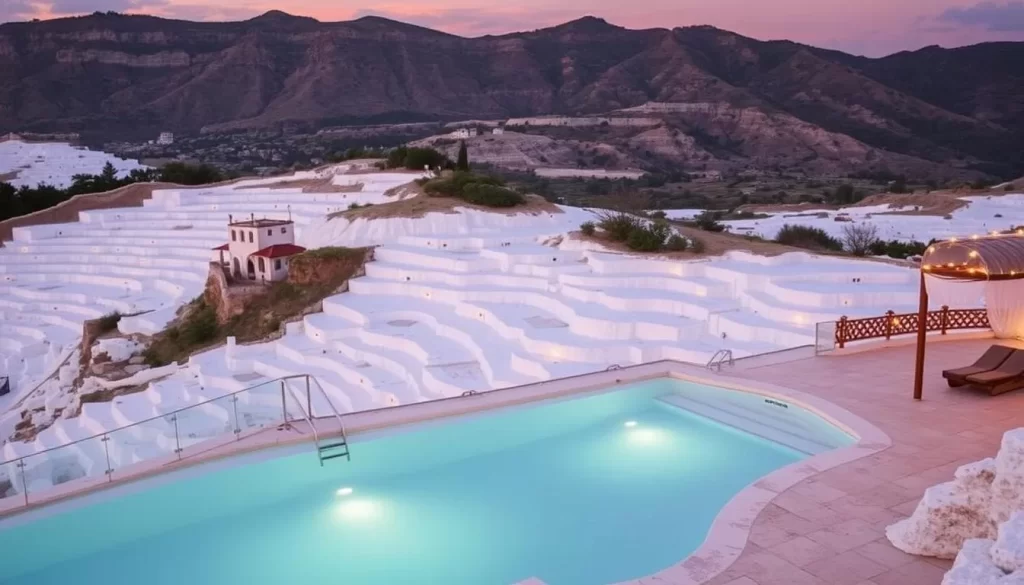
To make the most of your visit to Pamukkale, selecting the right place to stay is essential. You have three main areas to choose from, each offering different advantages depending on your preferences and budget.
Accommodation Options in Pamukkale Town
Pamukkale town provides the most convenient location for accessing the travertines and Hierapolis, with accommodations ranging from budget guesthouses to mid-range hotels, all within walking distance of the West Entrance. Staying in Pamukkale town allows you to visit the site early in the morning or late in the evening when day-trippers are gone, giving you better photo opportunities and a more peaceful experience. If you have a car, staying in Pamukkale town makes it easy to drive to the South Entrance, which provides the most direct access to the main attractions.
Staying in Nearby Karahayit or Denizli
For a more authentic and less touristy experience with better value, consider staying in Karahayit village, located just 5 kilometers from Pamukkale, known for its red thermal waters and more reasonable accommodation prices. Alternatively, Denizli city, about 20 minutes away by minibus, offers the widest range of accommodation options and amenities, from budget to luxury, and is ideal if you prefer urban conveniences or are traveling on a tight budget. Many hotels in all three areas offer thermal pools with the same mineral-rich waters found at the travertines, allowing you to enjoy the therapeutic benefits in a more private setting.
Practical Tips for an Unforgettable Pamukkale Experience
With these practical tips, you’ll be well-prepared to explore Pamukkale and create lasting memories. To make the most of your visit to Pamukkale, it’s essential to be aware of the site’s specifics, including the entrance fee and opening hours.
The entrance fee to Pamukkale and Hierapolis is approximately 30 EUR, granting access to both the travertines and the ancient city, as well as the Hierapolis Archaeology Museum. If you plan to swim in Cleopatra’s Antique Pool, be prepared for an additional fee of around 200 TRY.
Opening hours vary by season: during summer, the site is open from 6:30 AM to 8 PM. Allocate at least 4-5 hours to explore the travertines, Hierapolis, and the museum. Don’t forget to bring water, sunscreen, and a hat, especially during the summer months. Consider hiring a local guide or joining a tour for deeper insights into the site’s historical and geological significance.
The above is subject to change.
Check back often to TRAVEL.COM for the latest travel tips and deals.
